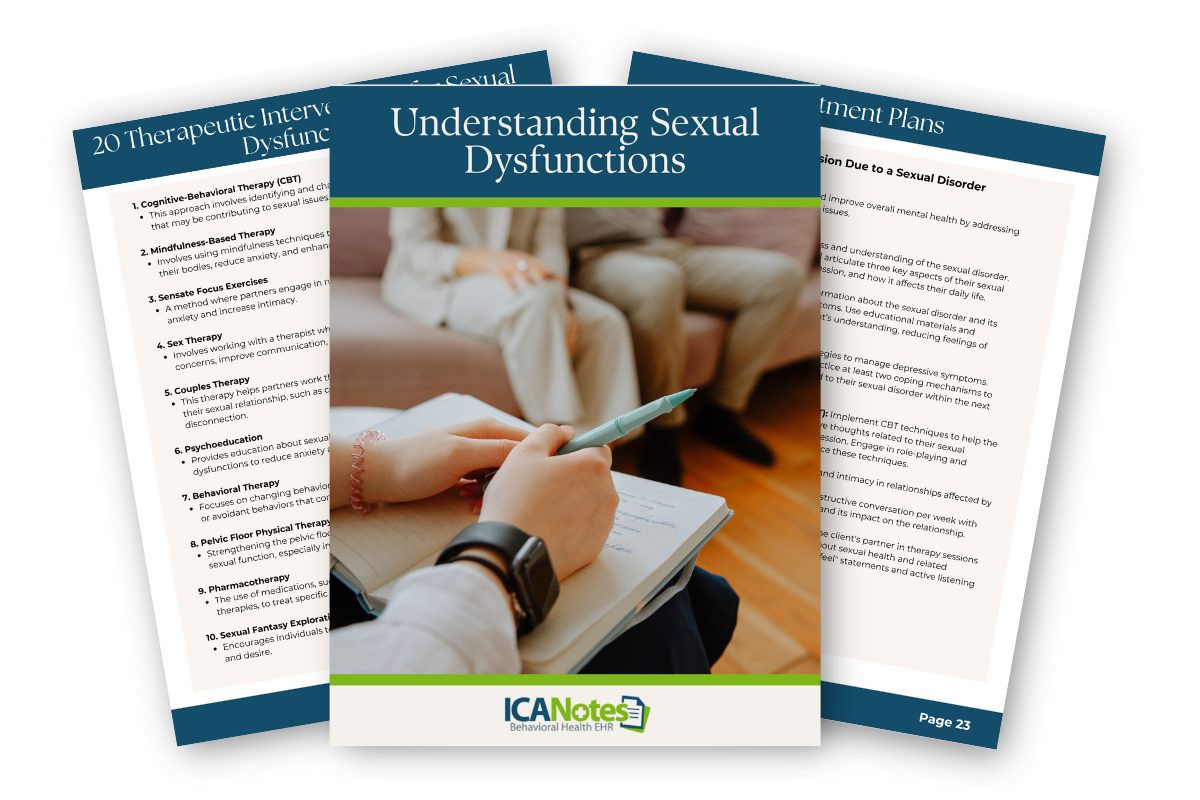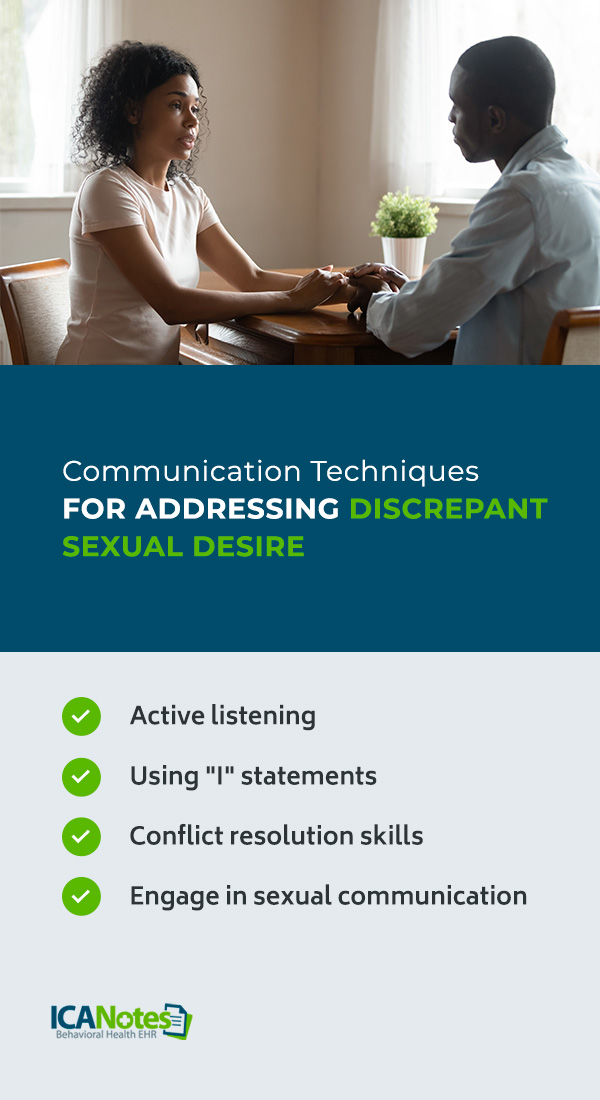
Bridging the Gap: Addressing Sexual Desire Discrepancy in Couples Therapy
Couples seek therapy for various reasons, including emotional disconnection, infidelity, poor communication and financial challenges. One of the most common conflicts you'll encounter as a clinician in couples therapy is sexual desire discrepancy. When one partner has a significantly higher or lower sex drive than the other, it can put a strain on the relationship on an emotional, physical and psychological level.
Desire discrepancy in marriage or partnership can be challenging to address primarily because there is no "normal" frequency for sexual intimacy. Restoring physical intimacy in couples therapy requires a delicate balance of respecting each partner's needs while providing ethical, effective support. If you've noticed more couples seeking counseling for differences in sexual desire at your practice, use this guide to explore strategies and techniques for success.
What Is Sexual Desire Discrepancy?
Sexual desire discrepancy occurs between partners in a romantic relationship when one person has a higher desire for sex than the other. The higher-desire partner often feels rejected or undesired by the lower-desire partner. Alternatively, the lower-desire partner may be content with less frequent sexual intimacy but feel pressured by their partner to engage in sex more often.
This experience can also be referred to as libido mismatch or desire disparity. Sexual desire discrepancy can often lead to dissatisfaction, tension and conflict in the relationship — which can be exacerbated by lack of communication.
FREE Download: Download this valuable resource for clinicians looking to better address the link between sexual health and mental health. The guide contains practical approaches for integrating sexual health into mental health treatment, improving overall patient outcomes.

How Common Is Sexual Desire Discrepancy?
Many researchers agree that desire discrepancy is one of the most common challenges in a couple's sexual health. Some professionals claim it may actually be inevitable in most long-term relationships. Having different levels of desire is perfectly normal in all romantic relationships, especially when considering the various life challenges that often take priority over sexual intimacy. Unfortunately, sexual desire discrepancy can be quite distressing for some couples due to harmful societal expectations, such as believing:
- Their desire is too high or too low.
- It is wrong for a female partner to have higher sexual desire than a male partner.
- Desire differences reflect poorly on their compatibility as a couple.
- Changes in desire or sexual preferences mean there is something wrong with the relationship.
- Women's sexual desire varies over time, whereas men's is stable.
Exploring Root Causes of Desire Discrepancy
One of the first topics you may want to address with your clients is their assumptions and misconceptions about desire discrepancy. Providing this guidance can help both partners understand that all levels of desire are "normal" and allow them to feel more at ease. Here are some common factors that lead to sexual desire discrepancy.
Libido Mismatch
Every individual has a unique libido, otherwise known as a sex drive or desire for sexual activity. At any point, romantic partners can experience mismatched sex drives influenced by biological, psychological and hormonal factors, such as:
- Fluctuations in sex hormones, including estrogen, testosterone and progesterone.
- Health conditions such as cancer, diabetes or heart disease.
- Medications, such as antidepressants.
- Hormonal contraception.
- Poor communication.
- Lack of trust.
- Stress, anxiety or depression.
- Excessive physical activity.
- Pregnancy.
- History of sexual trauma.
- Body image and self-esteem.
Sexual Dysfunction
It's important to note that this is not an exhaustive list of factors that may affect an individual's libido. Certain underlying sexual dysfunction conditions can also impact an individual's libido, sexual interest, arousal, orgasm and sexual pain. One of the most common conditions that affects sexual well-being is Hypoactive Sexual Desire Disorder (HSDD). This condition results in the mental and physical absence of sexual desire or sexual fantasies for an extended period.
Though it is classified in the Diagnostic and Statistical Manual of Mental Disorders (DSM), HSDD is generally underdiagnosed. If left untreated, it can result in emotional distress, decreased intimacy, lower self-esteem, lower satisfaction with partners and overall lower quality of life.
Individuals with sexual dysfunctions like HSDD have a 130% to 210% higher risk of developing depression than individuals without these conditions. HSDD is most common in women, but men can also develop this condition.

Emotional Intimacy
Emotional intimacy is an important foundation of most romantic relationships. A deep emotional connection between partners helps build trust, support and a sense of belonging in the relationship. This bond that partners share allows them to feel secure in being vulnerable and engaging in deep, meaningful conversations. Emotional intimacy can also improve mutual understanding, respect, forgiveness and empathy.
A lack of emotional intimacy can result in reduced sexual interest and an unfulfilling sexual connection. Here are a few example techniques to help your clients enhance emotional intimacy:
- Talking often about common interests and future goals
- Putting more effort into date nights or romantic surprises
- Addressing issues promptly and thoroughly to avoid resentment
- Treating your relationship as a priority
First-Session Assessment for Desire Discrepancy
As a therapist who specializes in relationship or sex counseling, educating your clients is one of the most important tools at your disposal. Societal expectations and misconceptions about sexual intimacy can make some individuals feel like there is something "wrong" with them, particularly if their level of desire has recently — and substantially — changed.
If you work with couples, you know how complex it can be to tackle conflicts about sex and sexuality. Easing your patients into their first session can encourage them to engage and participate. Explaining your client-therapist dynamic can be helpful for couples or individuals who have never been to therapy.
It's normal for couples to feel awkward or embarrassed when discussing their sexual desire, so it's critical to use a non-judgmental approach and assure them that there are no right or wrong answers. This can help you build trust and rapport with each session.
You can also help break the ice and encourage your couple to be more open by administering a sexual health assessment tool.
Sexual Health Assessment Tools
Assessment tools can give you and your patients a starting point in sex therapy for intimacy issues. They can help you identify sexual concerns or dysfunctions and inform your treatment plan. Common sexual health assessment tools therapists can use include:
- The Sexual Health Assessment of Practices and Experiences (SHAPE): The World Health Organization developed this questionnaire that assesses sexual practices, behaviors and health-related outcomes.
- Personal Assessment of Intimacy in Relationships (PAIR) Inventory: This systematic, 36-item tool outlines the five types of intimacy, which include emotional, social, sexual, intellectual and recreational intimacy.
- Basson's model of sexual functioning: This is a non-linear model of sexual response that assesses sexual function based on psychological and relationship factors. It also covers responsive and spontaneous desire.
- Female Sexual Function Index (FSFI): This 19-item questionnaire focuses on female sexual feelings over several weeks, including desire, arousal, lubrication, orgasm, satisfaction and pain.
Other assessments may be given depending on each partner's medical and mental health history.
Communication Techniques for Addressing Desire Discrepancy
Everyone experiences different desire styles. However, couples with poor communication can have difficulties trying to explain their thoughts, feelings and preferences openly. You can implement one or more of the following communication strategies in couples therapy to encourage positive conversation.
- Active listening: Many disagreements never see a solution because each partner is focused on what they're going to say or refute next. Active listening can teach the couple how to fully listen to each other without interrupting and display empathy for each other's wants and needs.
- Using "I" statements: An individual may feel defensive if they believe their partner is blaming or accusing them. Encourage each partner to use "I" statements to prevent defensiveness, such as "I feel angry when you don't help me clean the house and then try to initiate sex."
- Conflict resolution skills: Handling mismatched libidos can be challenging if the couple does not have healthy ways of solving disputes, disagreements and arguments. Conflict resolution skills can range from compromising and setting healthy boundaries to clearly communicating one's needs.
- Engage in sexual communication: Encourage your couple to directly communicate their sexual interests, needs and desires with each other. Discuss how a lack of desire may result from misunderstanding and how communicating when and how they want to have sex can be helpful.
Other practical communication tips you can discuss with your patients include:
- Being respectful during disagreements.
- Knowing when to apologize.
- Not assuming one knows what's best for the other.
- Being aware of body language, facial expressions and tone of voice.
Enhancing Sexual Satisfaction
When sexual desire discrepancy occurs, it usually means one person is distressed because they are constantly rejected when they initiate sex. Meanwhile, the other partner may feel nagged or overwhelmed by the constant desire for sex, making it less appealing. Neither one of these individuals is abnormal. The solution is to find a strategy that helps the couple build sexual intimacy, which can include:
- Identifying individual desires: Ask each partner to explain their ideal way of feeling desired, wanted and connected to their partner. Is sex or physical intimacy the priority? What are their individual sexual goals?
- Building physical connection: In cases where a high-desire partner wants more attention and the lower-desire partner wants more autonomy, you can encourage your couple to build physical intimacy by hugging, slow dancing, getting massages together or even scheduling time for sex.
- Exploring new experiences together: Bringing two partners closer emotionally can strengthen their bond and help them become more vulnerable with each other. Encourage the couple to try new activities, such as taking dancing lessons, cooking classes or volunteering together.
- Addressing unresolved issues: Trust issues, past hurts and resentment can hinder one partner's sexual desire for the other. Each partner should address any unresolved conflicts that may get in the way of sexual satisfaction.
Ethical Considerations in Sex Therapy
Adhering to ethical guidelines is a mandatory component of structuring effective therapy sessions. As with any type of therapy session, it's important to cultivate a safe, judgment-free therapeutic environment for the couple.
Addressing sexual desire discrepancies and intimate relationship dynamics can be sensitive for many individuals, so be sure to handle these topics with care and always remain unbiased. Maintain professional boundaries to ensure both partners feel comfortable being vulnerable and accepting therapeutic recommendations.
As a couples counselor or sex therapist, you're also responsible for ensuring client privacy and confidentiality. You'll want to take effective measures to prevent unauthorized access and remain in compliance with privacy laws.

Therapeutic Interventions for Desire Discrepancies
Counseling plays a vital role in helping a couple develop empathy and acceptance of one another. Consider using the following therapy techniques for sexual intimacy and desire discrepancy issues.
1. Cognitive Behavioral Approaches
Cognitive behavioral therapy (CBT) focuses on altering dysfunctional behaviors and beliefs that interfere with specific issues, such as desire discrepancy. One study found that CBT has been proven to positively influence women's sexuality and can be particularly effective at treating Hypoactive Sexual Desire Disorder. This study revealed that encouraging participants to discuss their feelings and beliefs about sexual activity helped them effectively identify dysfunctional thought patterns.
Using a CBT approach during couples therapy may help you address underlying issues or causes of mismatched sexual desire in your patients.
2. Sensate Focus Exercises
Sensate focus emphasizes building sensuality rather than sexuality. These exercises can help both partners focus on experiencing the sensation of being touched without any pressure to respond or react in a certain way. Sensate focus exercises are relatively simple and consist of one partner being the "toucher" and one the "receiver." Each partner takes turns touching the other to enhance sensory awareness.
3. Setting Realistic Expectations
Sexual desire and arousal are complex and ever-changing. In a long-term relationship, couples may experience many fluctuations in their sex life. These fluctuations can sometimes lead to frustration and resentment, so it's critical for the couple to develop acceptance of the other's needs. Your role as the unbiased therapist is to normalize both partners' experiences and guide them to set healthy and realistic expectations.
For example, the high-desire partner may need to address their need to feel desired only through the act of sex and learn how to self-regulate. Alternatively, the low-desire partner may need to set boundaries while taking some time to learn about their sexual interests.
Couples Assessment and Outcome Measurement
Monitoring patient progress is a routine part of your role as a clinician. You can measure the effectiveness of therapeutic interventions for sexual desire discrepancy by using intuitive charting tools for ongoing assessment. As couples make progress or hit roadblocks, you can refer to previous session notes to identify where you can make adjustments.
Why Trust ICANotes?
Between your long list of patients and administrative tasks, you have many responsibilities to manage. At ICANotes, we help behavioral health clinicians like you meet specific assessment, therapy and integrated care needs. Our clinically robust electronic health record (EHR) system addresses the common pain points of behavioral health clinicians and organizations, from increased healthcare complexities to outdated practice management processes.
Our integrated behavioral health software was designed by clinicians with a deep understanding of behavioral health. We understand the factors that make your job more difficult and stressful, which is why we created a solution to give you peace of mind.
Measure Client Progress More Effectively With ICANotes
Sexual desire discrepancy can negatively impact a relationship by putting strain on the emotional and physical intimacy between two partners. Fortunately, setting realistic expectations and collaborating on mutual goals can help couples improve their desire gap.
To keep track of your patient's progress and measure outcomes effectively, it's essential to maintain accurate clinical documentation. With ICANotes, you can keep couples' therapy notes organized in intuitive EHR software for behavioral health clinicians. Our solution can help you improve your quality of care and automate many aspects of practice management so you can spend less time on documentation and more time with your patients. Request your free trial with ICANotes today book a demo online.
Sources:
- https://pubmed.ncbi.nlm.nih.gov/38234271/
- https://www.nytimes.com/2023/08/11/well/family/sex-drive-libido-partner.html
- https://my.clevelandclinic.org/health/diseases/15216-low-libido-low-sex-drive
- https://www.ncbi.nlm.nih.gov/books/NBK603746/
- https://www.ncbi.nlm.nih.gov/books/NBK603746/
- https://staging.icanotes.com/2024/04/18/emotionally-focused-couples-therapy/
- https://iris.who.int/bitstream/handle/10665/375232/9789240085909-eng.pdf?sequence=1
- https://depts.washington.edu/uwcssc/sites/default/files/hw00/d40/uwcssc/sites/default/files/Personal%20Assessment%20of%20Intimacy%20in%20Relationships%20(PAIR).pdf
- https://med-fom-brotto.sites.olt.ubc.ca/files/2022/01/Brotto-and-Graham-2021-JSMT-1.pdf
- https://scireproject.com/wp-content/uploads/2022/04/FSFI-Scoring-Appendix.pdf
- https://staging.icanotes.com/2024/05/08/recognizing-highly-sensitive-person-traits/
- https://staging.icanotes.com/features/security/
- https://www.ncbi.nlm.nih.gov/pmc/articles/PMC9334335/
- https://health.cornell.edu/sites/health/files/pdf-library/sensate-focus.pdf
- https://staging.icanotes.com/features/charting/therapy/
- https://staging.icanotes.com/free-trial/
- https://icanotes.as.me/demos









